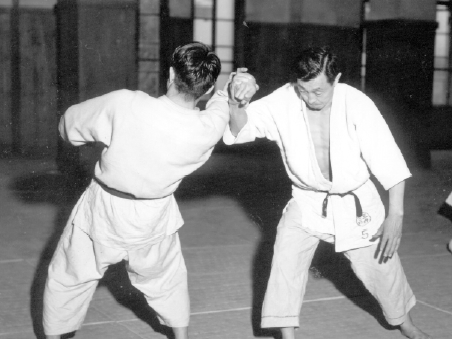

In Japan from long ago there were martial arts such as jujitsu where one could ward off an attack empty handed. There are 179 schools documented. There were many kinds of techniques that catered for all sorts of situations but we can classify them broadly into two categories. First, there are techniques that involve grabbing an opponent's clothing (sleeves, collars, etc.) when at close range.
Secondly, there are techniques against strikes (punches, kicks or with weapons) where there is some distance between opponents.The records of Yoshinryu Jujitsu state that they had no techniques aimed at killing an opponent. According to the Daitoryu Aikijujitsu tradition they 'neither cut nor are cut, neither punch nor are punched, neither kick nor are kicked'. The central aim of jujitsu was to hold down or throw an opponent without killing him whilst at the same time preventing his attack totally.
Today's competitive judo is a modern budo formed by Jigoro Kano Shihan (1860-1938) at the beginning of the Meiji era by deducing consistent principles from the old styles of jujitsu. Using these 'judo principles' as a basis, he established a randori practice system using throwing and holding techniques that made competitive matches possible.In Daitoryu Aikijujitsu, passed down in secrecy by the Aizu clan, the atemi waza (striking techniques) and kansetsu waza (joint techniques) were particularly good. The revival of Daitoryu Aikijujitsu in the Meiji era was the work of Sokaku Takeda (1860-1943).
In his youth he had also studied Onoha Ittoryu Kenjitsu, Jikishinkageryu Kenjitsu and Hozoinryu Sojitsu so he incorporated these sword techniques into Daitoryu Aikijujitsu. Historically, the study of the atemi waza and kansetsu waza was highly recommended at the beginning of the Edo era. This was because of the move from armour clad combatants on battlefields to peaceful times with people wearing ordinary clothes. In other words, jujitsu became a method of self-defence and hence the absorption of sword principles into unarmed jujitsu.
On this point Daitoryu Aikijujitu was particularly good. Takeda's best pupil, Morihei Ueshiba (1882-1969), had started by studying Tenjin Shinyouryu, Kitoryu, Yagyuryu and other styles of jujitsu. When he was 32 he studied with Takeda and demonstrated his great talent. Ueshiba, a deeply religious man, changed the name Aikijujitsu to Aikido after his spiritual awakening and understanding of aikido as a divine creation.Traditionally, the aikido practice system involved kata which means that the techniques are pre-arranged with one person executing the technique on another person. Competitive aikido has a randori practice system in addition to a kata practice system.
In kata, it is impossible to use the old jujitsu style techniques freely, in particular, trying to grab the chance to win in serious offensive and defensive situations or understanding the connections and transitions between one technique and another. Competitive aikido uses the atemi waza and kansetsu waza that were mostly ignored in judo competition.In a radio program in 1926 entitled 'Judo, Past and Present' Kano Sensei said, "Finding a way to do randori and hold competitions which allowed the use of atemi waza would be extremely difficult. Judging the techniques would be even more so." (see The Life Story of Jigoro Kano published by Kodokan).
Kano Sensei thought of ways to incorporate atemi waza into judo but was unsuccessful. Following his ideas, to modernise the techniques of the old styles of jujitsu another randori system separate to judo was required.The research of atemi waza and kansetsu waza was my incentive for entering the school of Morihei Ueshiba Sensei.
After 50 years of trial and error I have gradually put together an aikido randori method that is distinct from judo randori. To complete it though, as the history of competitive judo and kendo shows us, I will need years of cooperation and the collected wisdom of many people.Aikido has its own characteristics and historical value so I think it should rank as the third Japanese budo alongside kendo and judo, particularly as a budo in schools. To achieve this we must have both kata practice and randori practice.
There were many different schools of the old jujitsu styles that were in conflict with each other. However, with the formation of a randori and competition system in kendo in the middle of the Edo period and in judo at the beginning of the Meiji period, they gradually began to unify as a harmonious budo emerged.Aikido has a large number of techniques used in a variety of situations so it takes a long time to master.
It is a lifelong study. However, it is important to make sure that the important techniques and representative situations are found in competition.Kata are one part of budo where techniques must be learned. However, we are unable to train hard against someone competitively as in a match situation where we can polish up our techniques and spirit.
In particular, we can objectify our true ability and aim to improve.People can experience the hard training when they are young and continue to practise kata throughout their lives which is a characteristic of Japanese budo. It is also conforms to the modern demands for a lifelong physical education. I am confident that aikido is the best budo to meet these conditions.
Source unknown.